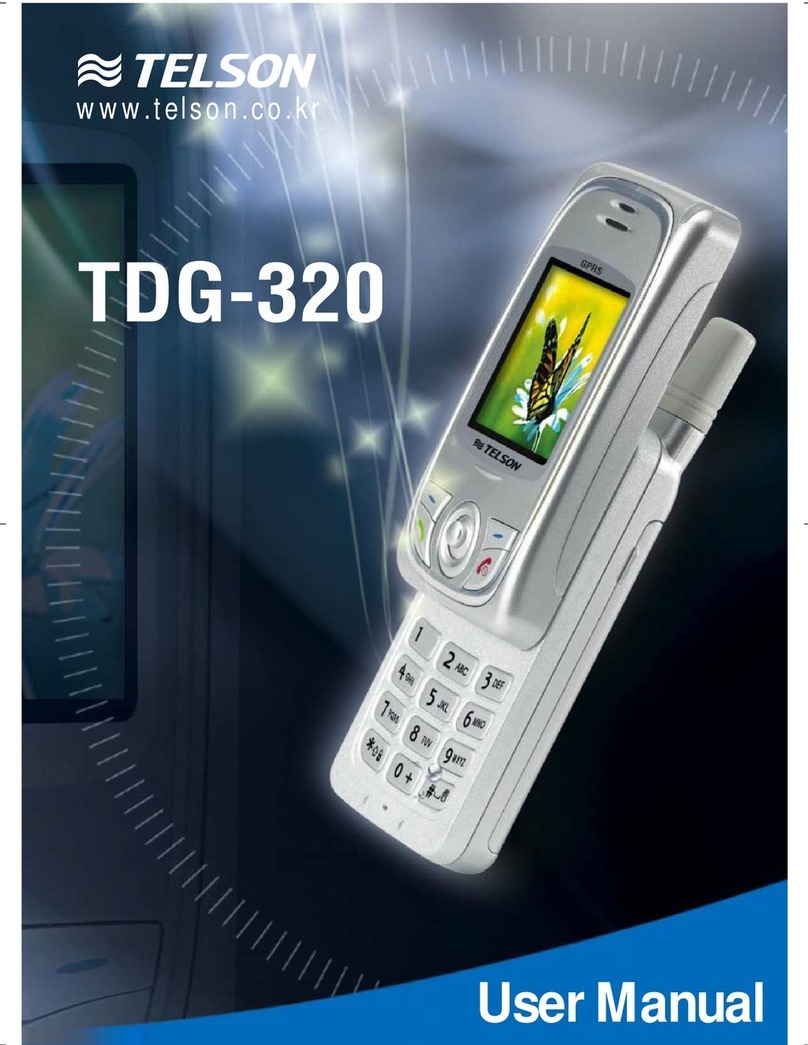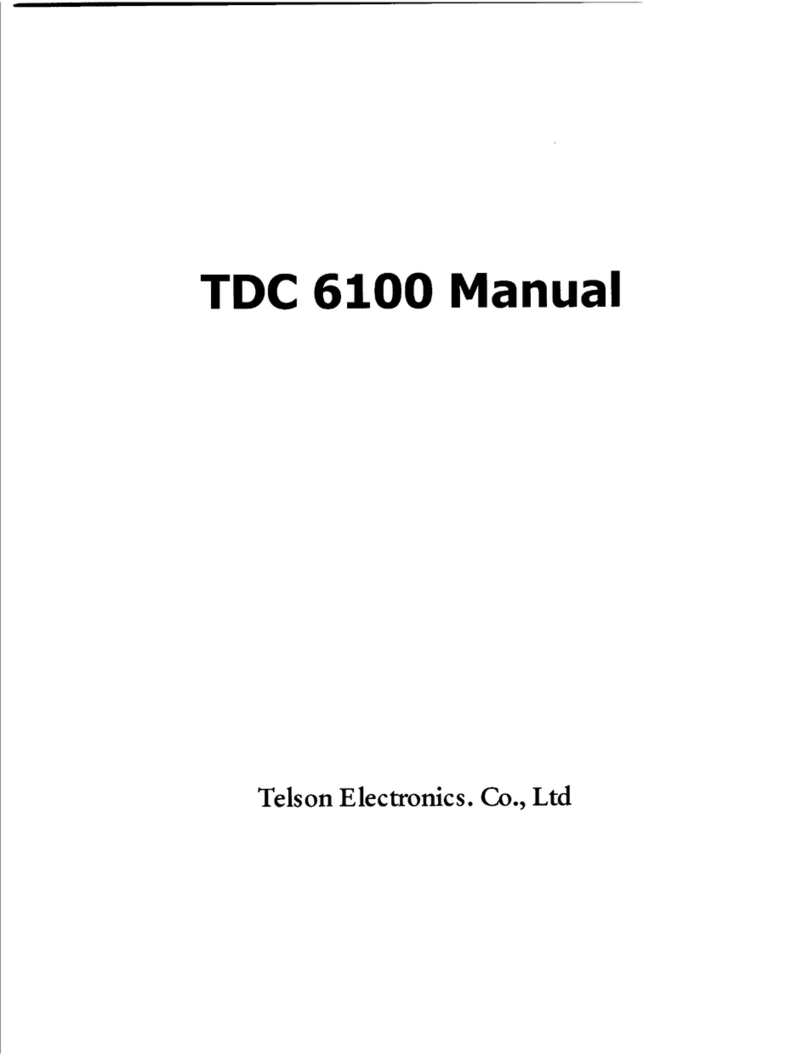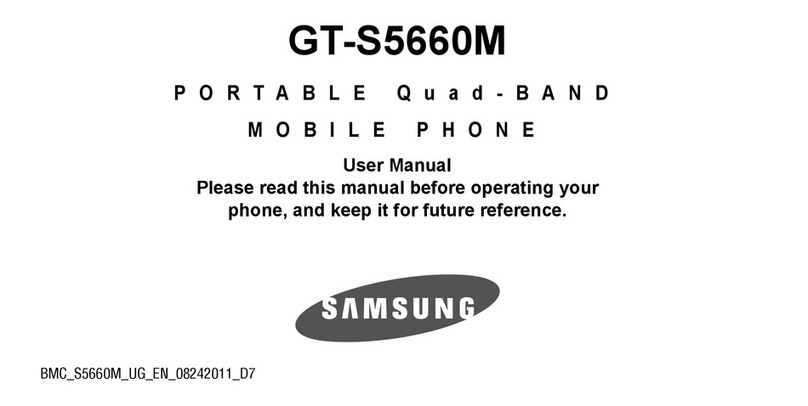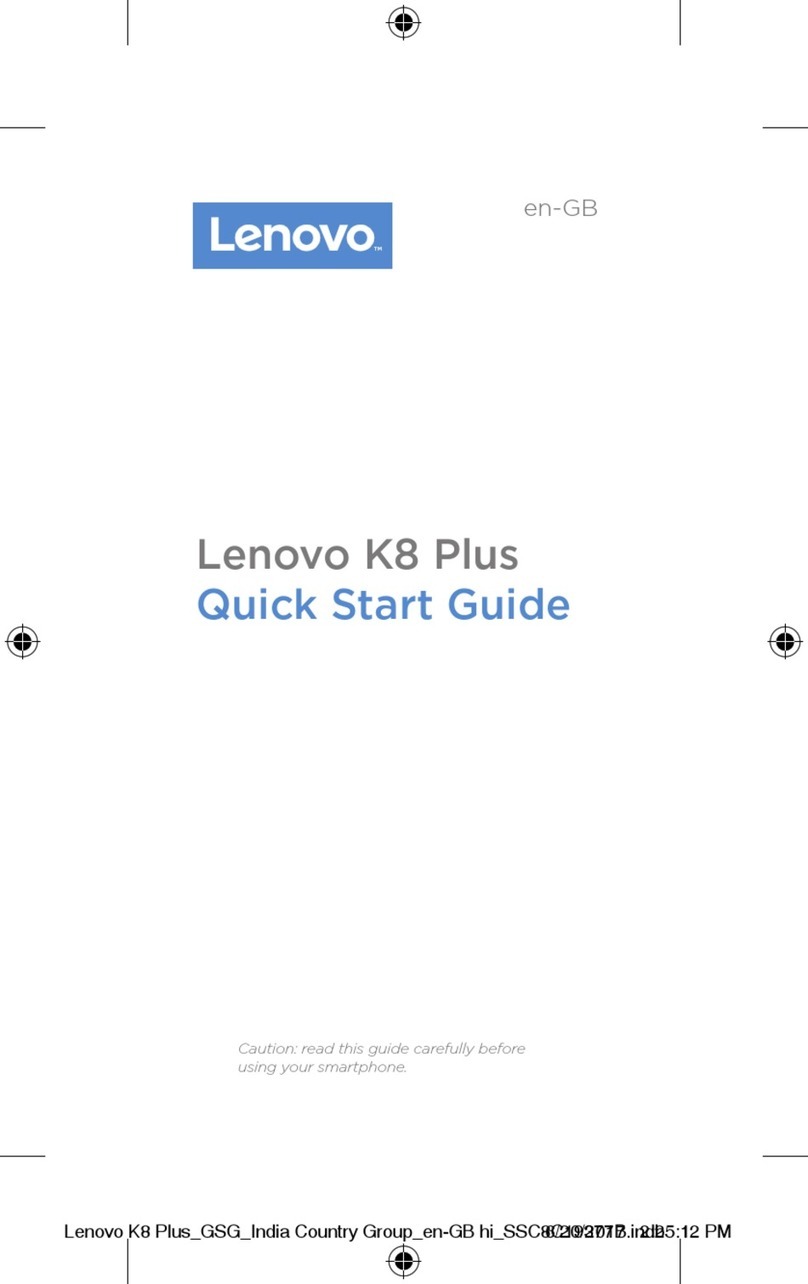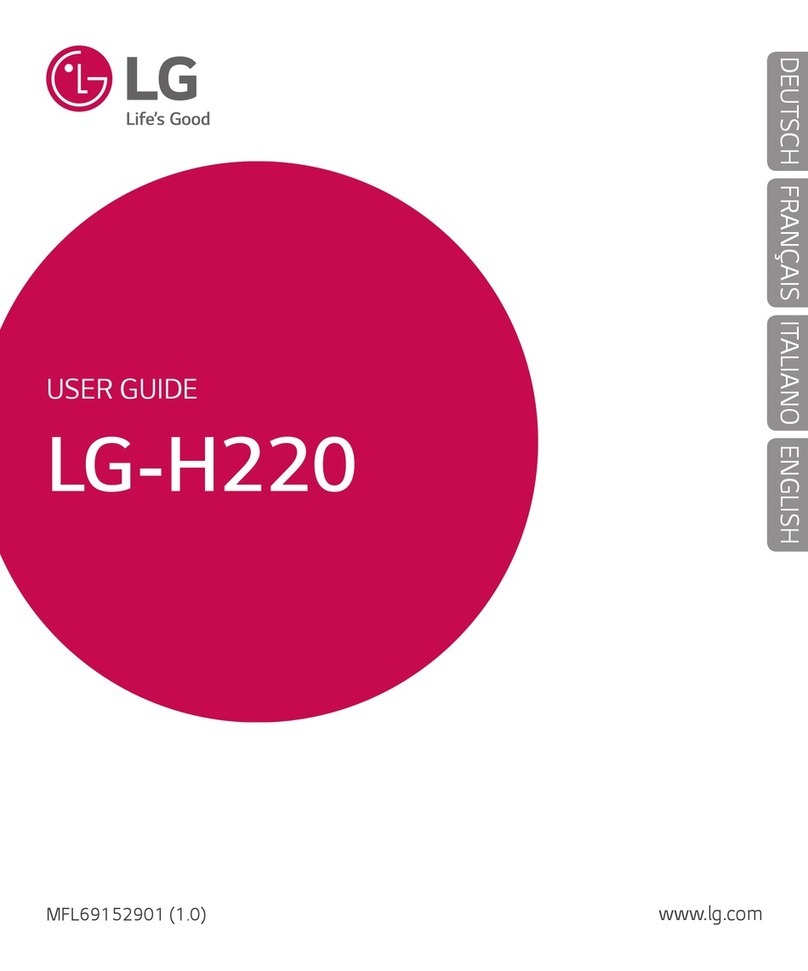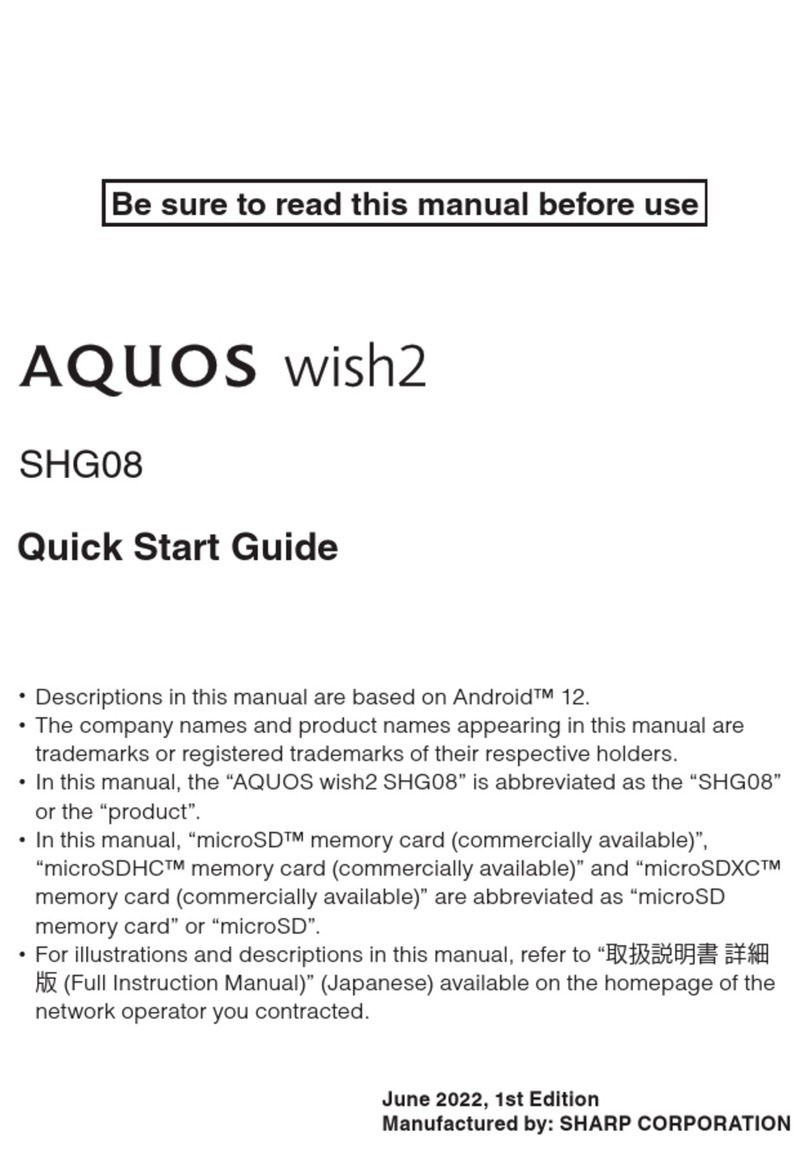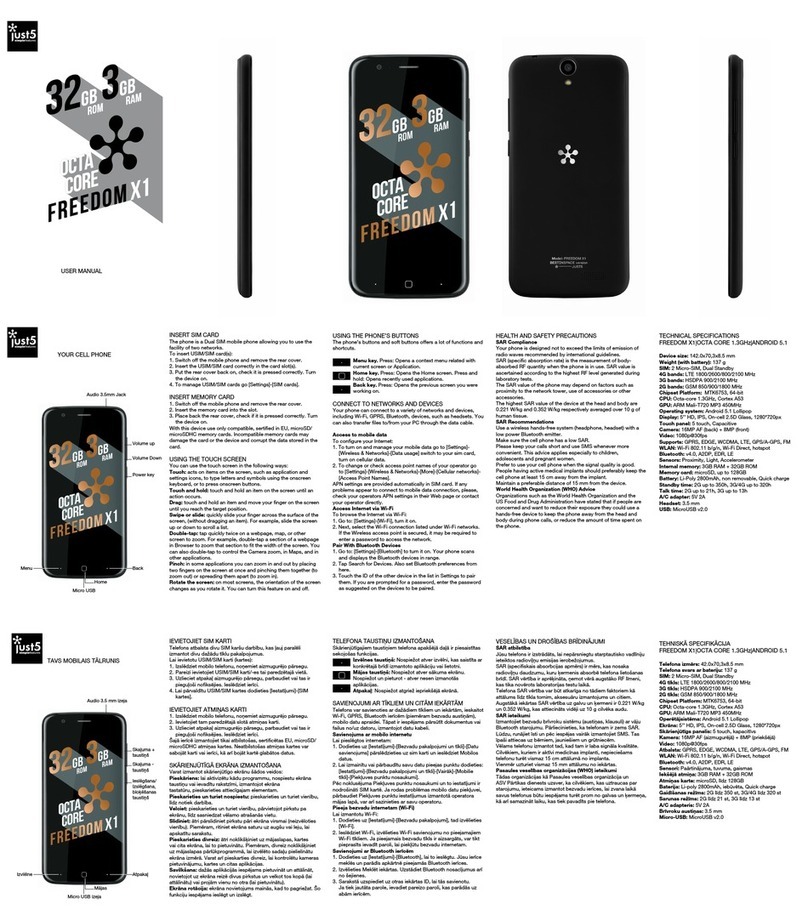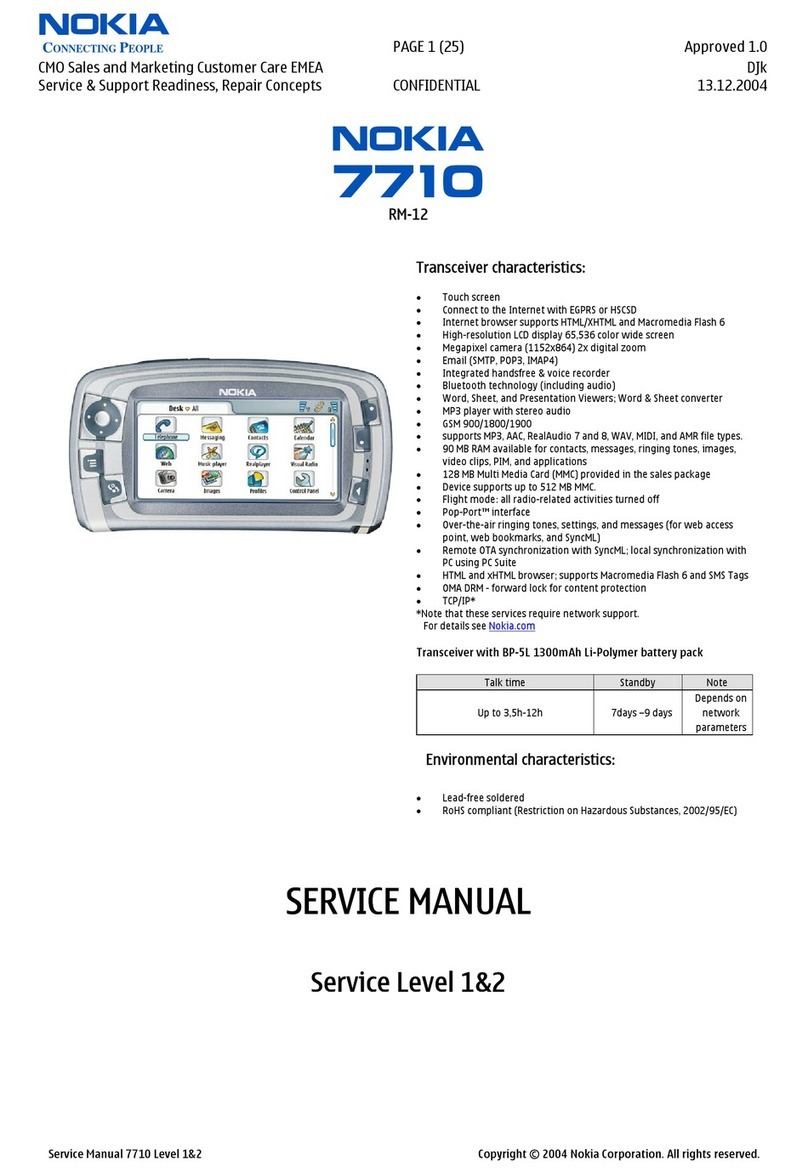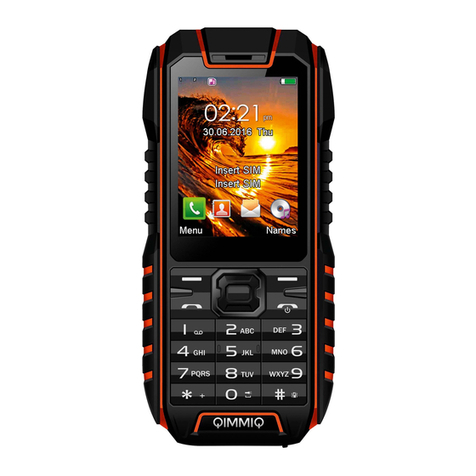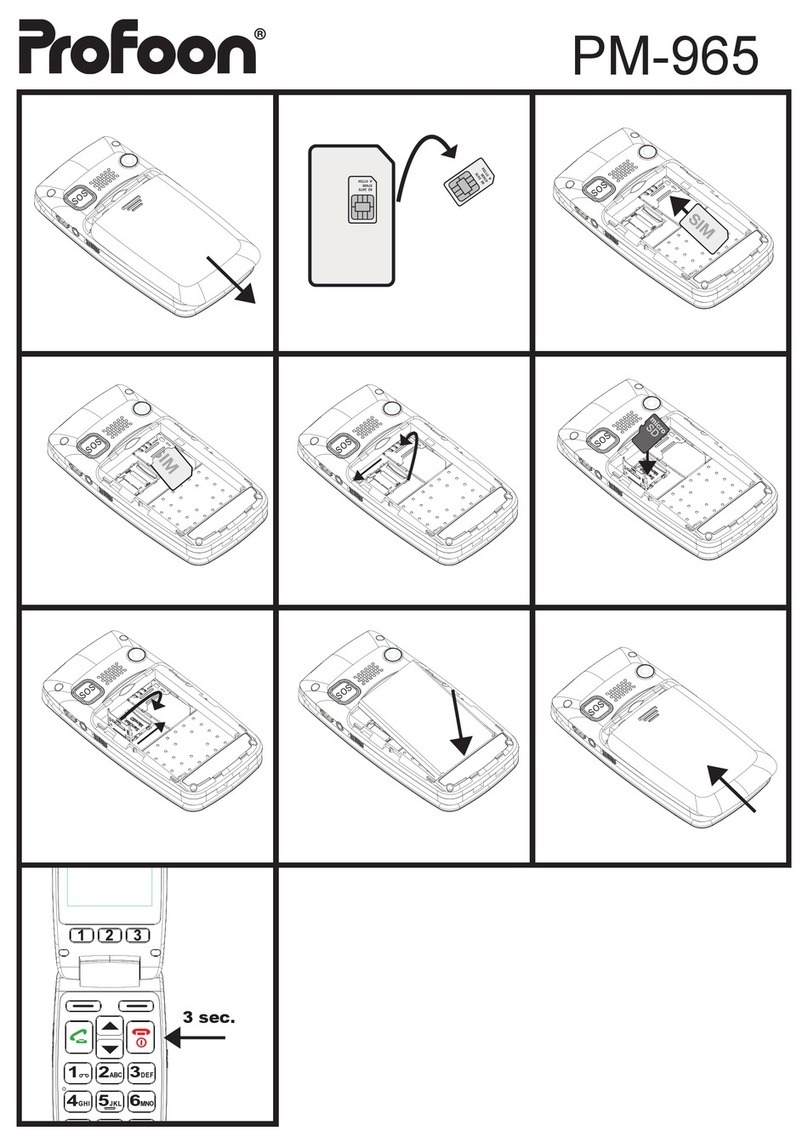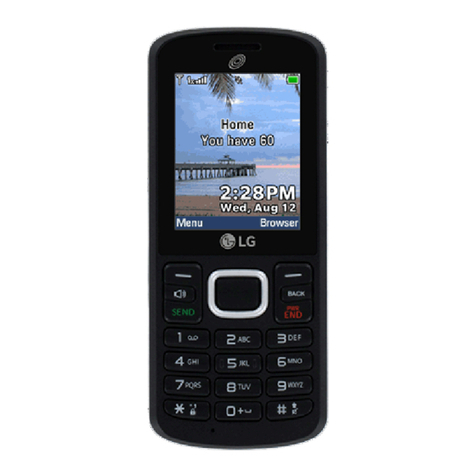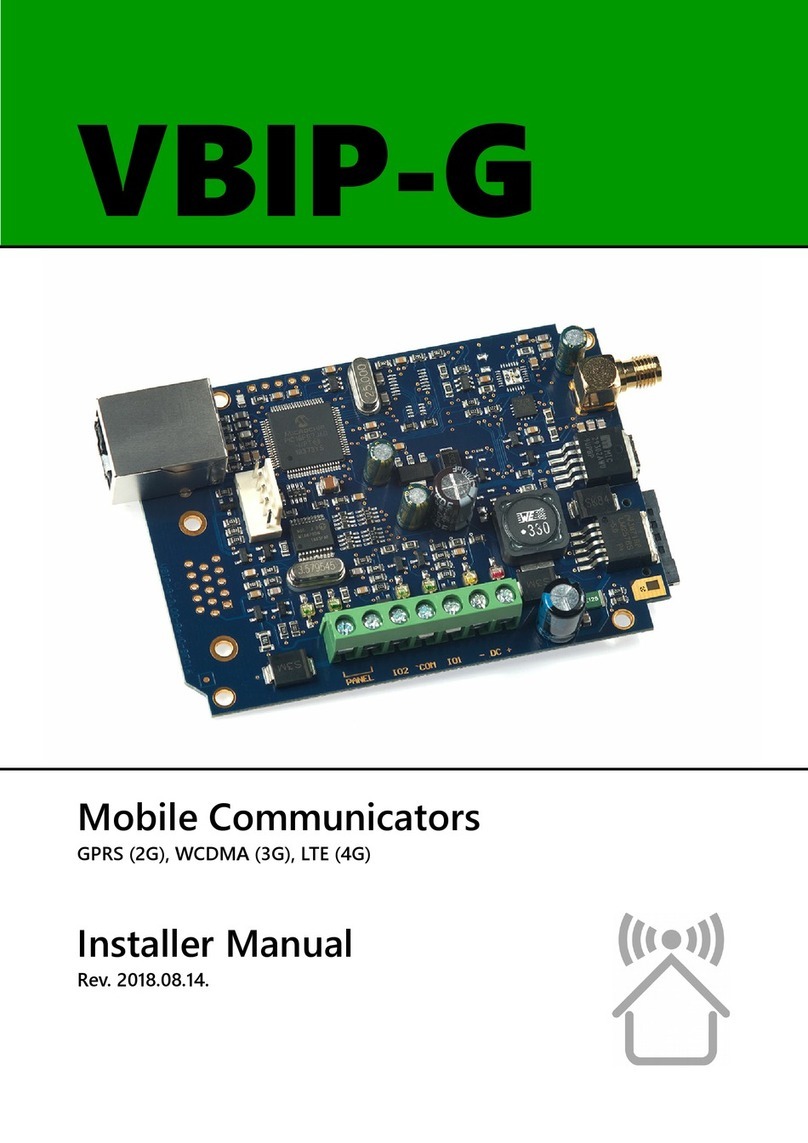Telson TDC-8020 User manual


2
Welcome
Thank you for choosing Telson-global leader in communications technology. All Telson phones
are designed and manufactured to meet Telson exacting specifications and world-class quality
standards. During development, our laboratory testing team took the durable TDC-8020 phone
through its paces. They cooked it, steamed it, shook it, shocked it, dusted it, and dropped it and
the phone still worked! We are confident that the one you purchased will meet your own
exacting standards. Thank you for choosing Telson, and by all means, enjoy your TDC-8020
dual mode digital cellular phone!.
*To meet FCC RF exposure requirements, this model must only be used held to ear.
No headset output provision is available from the connector at the bottom of the phone.
The reason this device has not been tested for body-worn SAR compliance is because it has no
provisions for headset output or use of belt-clips, holsters or other similar accessories for body-
worn transmission.
Guide Overview
Okay, you've got a brand new phone with a bunch of nifty features. Now what? Afraid you'll
press the wrong key? Or forget a feature or two? Don't sweat it! We've designed this guide to
take you step-by-step through each feature of your new TDC-8020 phone. We'll show you what
key to press and what happens when you press it. Follow along, chapter-by-chapter, and you'll
find it's as easy as 1-2-3. Here's an idea of what you'll learn in each chapter:
Getting Started
First things first. Turn to First page, and we'll explain what came with your phone. Then, we'll
show you how to install and charge your battery so that you can get started with "The Basics" in
the next section.
The Basics
What do all those buttons and lights mean? How do I make my first phone call? In this section,
we'll answer those questions and get you going with your TDC-8020 phone.
Using Memory
Read "Using Memory,"
beginning and you'll learn how to make the most of your new phone's built-in Phone Book. You'll

3
save time with dialing shortcuts and memory tricks that make it easy to place quick calls.
Using Messaging
Did you know that your TDC-8020 phone supports optional messaging services, like Caller ID * ,
which allows you to see who's calling before you answer? Your new phone can even receive
alphanumeric messages just like a pager and tell you when you have Voice Mail*.
The Works
When you've ready to get into the more advanced features your new phone has to offer, just
turn to "The Works." Learn about everything from navigating themenu system to electronically
locking your phone. So relax! Let us show you what your TDC-8020 phone can do!
*Contact your Service Provider for availability.

4
Glance at unit
Front view (Flip closed) Front view (Flip open)
LED
SMS
Phone book
Internet
access
Power
On/Off
Lock key
Volume
control
Menu key
Vibration
key

5
Contents
Introduction
Safety Information . . . . . . . . . . . . . . . . . . . . . . . . . . . . . . . . . . . . . . . . . . . . . . . . . . . . . . . . . . 6
Getting Started
Package Content Options . . . . . . . . . . . . . . . . . . . . . . . . . . . . . . . . . . . . . . . . . . . . . . . . . . . . 9
Introduction to Batteries. . . . . . . . . . . . . . . . . . . . . . . . . . . . . . . . . . . . . . . . . . . . . . . . . . . . . . 9
Installing Batteries . . . . . . . . . . . . . . . . . . . . . . . . . . . . . . . . . . . . . . . . . . . . . . . . . . . . . . . . . . 9
Charging Batteries . . . . . . . . . . . . . . . . . . . . . . . . . . . . . . . . . . . . . . . . . . . . . . . . . . . . . . . . . .10
Phone Overview. . . . . . . . . . . . . . . . . . . . . . . . . . . . . . . . . . . . . . . . . . . . . . . . . . . . . . . . . . . .11
The Basics
Turning Your Phone On . . . . . . . . . . . . . . . . . . . . . . . . . . . . . . . . . . . . . . . . . . . . . . . . . . . . . .12
Reading the Indicators . . . . . . . . . . . . . . . . . . . . . . . . . . . . . . . . . . . . . . . . . . . . . . . . . . . . . . 13
Placing and Ending Calls. . . . . . . . . . . . . . . . . . . . . . . . . . . . . . . . . . . . . . . . . . . . . . . . . . . . .14
Receiving Calls . . . . . . . . . . . . . . . . . . . . . . . . . . . . . . . . . . . . . . . . . . . . . . . . . . . . . . . . . . . .15
Redialing Numbers. . . . . . . . . . . . . . . . . . . . . . . . . . . . . . . . . . . . . . . . . . . . . . . . . . . . . . . . . 17
Basic Tone Controls . . . . . . . . . . . . . . . . . . . . . . . . . . . . . . . . . . . . . . . . . . . . . . . . . . . . . . . . 17
Your Phone & Its Shortcuts . . . . . . . . . . . . . . . . . . . . . . . . . . . . . . . . . . . . . . . . . . . . . . . . . . .19
Using Memory
Introduction . . . . . . . . . . . . . . . . . . . . . . . . . . . . . . . . . . . . . . . . . . . . . . . . . . . . . . . . . . . . . . .20
Making the Most of Memory . . . . . . . . . . . . . . . . . . . . . . . . . . . . . . . . . . . . . . . . . . . . . . . . . .20
Storing Names & Numbers. . . . . . . . . . . . . . . . . . . . . . . . . . . . . . . . . . . . . . . . . . . . . . . . . . . .21
Entering Names . . . . . . . . . . . . . . . . . . . . . . . . . . . . . . . . . . . . . . . . . . . . . . . . . . . . . . . . . . . .21
Recalling from Memory. . . . . . . . . . . . . . . . . . . . . . . . . . . . . . . . . . . . . . . . . . . . . . . . . . . . . . 22
Recall shortcuts . . . . . . . . . . . . . . . . . . . . . . . . . . . . . . . . . . . . . . . . . . . . . . . . . . . . . . . . . . . 23
Scratchpad . . . . . . . . . . . . . . . . . . . . . . . . . . . . . . . . . . . . . . . . . . . . . . . . . . . . . . . . . . . . . . .24
Pause dialing . . . . . . . . . . . . . . . . . . . . . . . . . . . . . . . . . . . . . . . . . . . . . . . . . . . . . . . . . . . . . 24
Using Messaging
Using Messaging. . . . . . . . . . . . . . . . . . . . . . . . . . . . . . . . . . . . . . . . . . . . . . . . . . . . . . . . . . .25
Receiving Messaging. . . . . . . . . . . . . . . . . . . . . . . . . . . . . . . . . . . . . . . . . . . . . . . . . . . . . . . 26
Viewing Your Caller IDs . . . . . . . . . . . . . . . . . . . . . . . . . . . . . . . . . . . . . . . . . . . . . . . . . . . . .27
Checking Your Voice Mail . . . . . . . . . . . . . . . . . . . . . . . . . . . . . . . . . . . . . . . . . . . . . . . . . . . 28
Voice Mail Options. . . . . . . . . . . . . . . . . . . . . . . . . . . . . . . . . . . . . . . . . . . . . . . . . . . . . . . . . 28
Reading Your Messages . . . . . . . . . . . . . . . . . . . . . . . . . . . . . . . . . . . . . . . . . . . . . . . . . . . . 29
Message Options. . . . . . . . . . . . . . . . . . . . . . . . . . . . . . . . . . . . . . . . . . . . . . . . . . . . . . . . . . 29
How to contact Telson. . . . . . . . . . . . . . . . . . . . . . . . . . . . . . . . . . . . . . . . . . . . . . . . . . . . . . .31

6
Safety Information
Exposure to Radio Frequency Signals
Your wireless handheld portable telephone is a low power radio transmitter and receiver. When
it is ON, it receives and also sends out radio frequency (RF) signals. In August 1996, the
Federal Communications Commissions (FCC) adopted RF exposure guidelines with safety
levels for hand-heldwireless phones. Those guidelines are consistent with the safety standards
previously set by both U.S. and international standards bodies:
üANSI C95.1 (1992) *
üNCRP Report 86 (1986)*
üICNIRP (1996)*
Those standards were based on comprehensive and periodic evaluations of the relevant
scientific literature. For example, over 120 scientists, engineers, and physicians from
universities, government health agencies, and industry reviewed the available body of
research to develop the ANSI Standard (C95.1). The design of your phone complies with the
FCC guidelines (and those standards).
Antenna Care
Use only the supplied or an approved replacement antenna. Unauthorizedantennas,
modifications, or attachments could damage the phone and may violate FCC regulations.
Phone
Operation
Normal Position:
Hold the phone as you would any other telephone, with the antennapointed up and over your
shoulder.
Tips on Efficient Operation:
For your phone to operate most efficiently:
"Extend your antenna fully.
"Do not touch the antenna unnecessarily when the phone is in use. Contact with the antenna
affects call quality and may cause thephone to operate at a higher power level than otherwise
needed.
*American National Standards Institute National Council on Radiation Protection and
Measurements International Commission on Non-Ionizing Radiation Protection

7
Batteries
Caution: All batteries can cause property damage, injury or burns if a conductive material, such
as jewelry, keys or beaded chains, touches exposed terminals. The material may complete an
electrical circuit and become quite hot. To protect against such unwanted current drain, exercise
care in handling any charged battery, particularly when placing it inside your pocket, purse or
other container with metal objects. When the battery is detached from the phone: your battery
is packed with a protective cover.;please use this cover for storing your battery when not in
use.
Driving
Check the laws and regulations on the use of wireless telephones inthe areas where you drive.
Always obey them. Also, if using your phone while driving, please:
üGive full attention to driving-driving safely is your first responsibility
üUse hands-free operation, if available
üPull off the road and park before making or answering a call if
driving conditions so require.
Electronic Devices
Most modern electronic equipment is shielded from RF signals. However, certain electronic
equipment may not be shielded against the RF signals from your wireless phone.
Pacemakers
The Health Industry Manufacturers Association recommends that aminimum separation of six
(6" inches be maintained between a handheld wireless phone and a pacemaker to avoid
potential interferencewith the pacemaker. These recommendations are consistent with the
independent research by and recommendations of Wireless Technology Research. Persons
with pacemakers:
üShould ALWAYS keep the phone more than six inches from their pacemaker when the
phone is turned ON
üShould not carry the phone in a breast pocket
üShould use the ear opposite the pacemaker to minimize the potential for interference.
üIf you have any reason to suspect that interference is taking place, turn your phone
OFF immediately.
Other Medical Devices
If you use any other personal medical device, consult the manufacturer of your device to
determine if they are adequately shieldedfrom external RF energy. Your physician may be able

8
to assist you inobtaining this information. Turn your phone OFF in health care facilities when
any regulations posted in these areas instruct you to do so. Hospitals or health carefacilities
may be using equipment that could be sensitive to external RF energy.
Vehicles
RF signals may affect improperly installed or inadequately shieldedelectronic systems in motor
vehicles. Check with the manufacturer or its representative regarding your vehicle. You should
also consult the manufacturer of any equipment that has been added to your vehicle.
Posted Facilities
Turn your phone OFF in any facility where posted notices so require. Aircraft FCC regulations
prohibit using your phone while in the air. Switch OFF your phone before boarding an aircraft.
Blasting Areas
To avoid interfering with blasting operations, turn your phone OFF when in a “Blasting area" or
in areas posted: "Turn off two-way radio." Obey all signs and instructions. Turn your phone OFF
when in any area with a potentially explosiveatmosphere, and obey all signs and instructions.
Sparks in such areas could cause an explosion or fire resulting in bodily injury or even death.
Potentially Explosive Atmospheres
Areas with a potentially explosive atmosphere are often, but not always, clearly marked. They
include fueling areas such as gasolinestations below deck on boats fuel or chemical transfer or
storage facilities areas where fuel odors are present, i.e. if a gas/propane leak occurs in a car or
home areas where the air contains chemicalsor particles, such as grain, dust, or metal powders
and any other area where you would normally be advised to turn off your vehicle engine.
Vehicles Equipped with Air Bags
An air bag inflates with great force. DO NOT place objects, includingboth installed or portable
wireless equipment, in the area over theair bag or in the air bag deployment area. If in-vehicle
wireless equipment is improperly installed and the air bag inflates, serious injury could result.
Equipment Care
Your Telson cellular radiotelephone is designed for excellent durability under normal use
conditions. Protect your cellular telephone from water damage that could result from spills or
excessive exposure to rain. Never submerge your cellular phone.

9
Getting Started
Package Content Options
The TDC-8020 phone comes equipped with a Lithium Ion battery and either a Travel Charger to
get you up and running. An exciting line of accessory options, nowsmaller and lighter than ever,
can customize your cellular pack-age for maximum performance and portability. Your phone and
accessories may not look exactly as pictured above.
TDC-8020 Dual Mode Phone
Lithium Ion Battery
Travel Charger (optional)
Introduction to Batteries
Battery Covers
Your phone's batteries are shipped uncharged, protected by a plastic storage case. You should
use this case to store and carry batteries. The storage case prevents objects from touching
the battery terminals, thereby reducing the risk of injury or damage from a short circuit.
To begin using your battery:
1. Unsnap Case
Unsnap the top of the plastic storage case.
2. Remove Battery
Remove the battery from the case and snap the case closed.
Installing Batteries
Battery Installation
Find the imprinted arrows on the top back of your phone.
1. Place Battery
Place the top of the battery just below the bottom of the imprinted arrows.
2. Slide Battery
Slide the battery up along the guides until it clicks into place.
Battery Removal
Make sure you phone is OFF before removing the battery.

10
1. Press Latch
Press the release latch on the top back of the phone.
2. Slide Battery
Slide the battery down until it comes free.
3. Remove Battery
Lift up the battery to remove.
Charging Batteries
Using the Travel Charger
The Travel Charger is a quick and easy way to charge your phone's battery. It's compact
enough to bring along and powerful enough to use at home.
Keep in mind: When the Travel Charger is in use and thephone is ON, you can still place and
receive calls. Just remember, talking on the phone requires energy, so your phone may
not charge while the call is in progress.
1. Attach Charger to Phone
Plug the Travel Charger into the accessory connector on the bottom of your phone.
2. Plug In Charger
Plug the charger into the appropriate power source.
PUSH
High Low
The Battery Indicator
In the upper right corner of your phone's display, there is a battery indicator filled with three
segments. The more segments you see, the greater the charge.
Battery Charging Times
The time it takes for your battery to obtain a full charge is affected by a variety of factors,
including:
üTemperature Batteries should be at or near room temperature when charging.
üInactivity New batteries, or batteries that have been stored for long periods of time,
may not rapid charge properly. In these instances, the battery requires an overnight
charge.

11
üExtended Usage Over extended periods of time, batteries gradually wear down and
require longer charging times.
üThis is normal. If you've been charging your battery regularly and notice a decrease in
talk-time or an increase in chargingtime, then it's probably time to purchase a new
battery.
Battery Storage and Disposal
To prolong the life of your batteries, avoid exposing them totemperatures below -10¡ÆC(14¡ÆF) or
above 45¡ÆC(113¡ÆF). As a good rule of thumb, always take your phone with you when youleave
your car.
To dispose of batteries, check with your local recycling center for a battery recycler near you.
Never dispose of batteries in fire.
Caution: To prevent injuries or burns, do not allow metal objects to contact or short circuit the
battery terminals.
Phone Overview
Function Keys
Alphanumeric Display Displays your input from the keypad, information recalled from memory,
the time and date transmitted by your digital service provider, messages, and more.
Microphone Positioned for convenient conversation.
Retractable Antenna Extend for best performance.
Earpiece Ultra-compact phone speaker.
Headset Jack Provides the connection for an optional headset.
Accessory Connector Provides the connection for an external power supply.
Volume Keys Represented in this manual by "and " these keys adjust keypad, earpiece, and
ringer volume. They also scroll up and down through memory locations and menu features.
Keypad Cover (or Flip) Open to answer close to hang up.
The Basics
The next few pages will introduce you to the basic features of your phone. In the chapters that
follow, we'll take you step-by-step through every one of your phone's features, including
storing names and numbers, using the call timers, locking the phone, and more.

12
Turning Your Phone On
Follow these steps to turn your phone ON and OFF:
1. Extend Antenna
Extend the antenna completely for best performance.
2. Open Flip
Open the keypad cover.
3. Turn ON Phone
Press “END Key”once to turn the phone ON.
4. Turn OFF Phone
Press “END Key”again to turn the phone OFF
What you will see:
Each time you turn your phone ON, it performs a short self-test to make sure it's operational and
then scans for service. While the phone scans, the display reads: Searching .
The Welcome Screen
When your phone finds a cellular signal, it displays Ready to let you know it's ready to use.
Tip:
If the Banner is programmed, you'll see that instead of Ready..
Turning Your Phone On
Dual Mode Operation
Dual Mode Operation enables you to make the best use of availablecellular signals. Using the
latest advances in CDMA technology, your new phone automatically switches between digital
and analog systems.
CDMA Digital
If your phone finds a CDMA digital system, you will see the indicator, along with the time and
date transmitted by the network.
Dual Number
Your phone can be activated with two unique phone numbers. If there's more than one phone
number programmed on your phone, you'll see the currently active number whenever you

13
turn on the phone.
Standby Mode
To conserve energy, your phone enters standby mode and turns off the back light when you
close the keypad cover or haven’ ttouched a key for a few seconds. The back light will come
back on as soon you press a key or open the keypad cover.
Reading the Indicators
Signal Strength (1)
Displays the strength of the connection between your phone and the local cellular system.
VibraCall™ On (2)
Indicates that your phone's ringer is turned OFF and the VibraCall alert is ON.
In Use (3)
Appears when a call is in progress.
Caller ID/Message (4)
Appears when you receive a Caller ID * or alphanumeric message. It will disappear after you've
viewed the Caller ID or read the message.
Voice Mail (4)
Indicates you've received a Voice Mail * message in your Voice Mailbox. It will disappear after
you've listened to the message.
Note: If the Voice Mail Indicator is flashing, you have at least two messages, one Caller ID /
Message and one Voice Mail message.
Roam (5)
Lights up when your phone accesses a cellular service outside of your home system. When you
leave your cellular service area, your phone roams (seeks another cellular system).
Digital (6)
Indicates you've on a digital channel, allowing for better voicequality. Check with your Service
Provider for more information.

14
Battery Level (7)
The three bar segments on the phone's Battery Level Indicator show the amount of charge
remaining in your battery. The morebar segments you see, the higher the charge. If your
battery is low, the phone alerts you in three ways:
üNo bar segments on the indicator will be highlighted.
üLow Battery will appear on your display.
üA hi-lo tone will sound periodically.
If you ignore these warnings, the phone will automatically turnitself OFF when the battery is
exhausted. At this point, you should charge the battery or insert a new battery.
Time and Date(8)
When your phone has a CDMA digital signal, the display shows the local time and date
transmitted by the network. You can choose to have the time displayed in 12-or 24-hour
format.
Detailed Battery Level Reading
The bar graph in the display represents the battery level. Thehigher the graph, the closer the
battery is to full charge.
Important: If the phone is being powered externally-from theTravel Charger for example-you will
see:
Power/Status Indicator
The Power/Status Indicator is on top of your phone and lights upbriefly when your phone is
turned ON. Read the chart below tolearn how to recognize your phone's state of service at a
glance, without even opening the phone.
Red, steady Incoming call.
Red, flashing Incoming message.
Press "to enter messaging.
Placing and Ending Calls

15
Placing a Call
1. Extend Antenna
Extend the antenna completely for best performance.
2. Open Flip
Open the keypad cover. If necessary, press "to turn the phone ON.
3. Enter Number
Enter the number you want to call, for example: 2140-1424.
Correct Errors Press "to erase one digit at a time if you make a mistake. Press &
hold "to erase the entire entry and start again.
4. Place Call
Press “SEND KEY”to place the call.
You will see: Dialing 2140-1424.
You can dial phone numbers with up to 32 digits, but only thelast twenty-four digits will appear
in the display.
Ending a Call
There are two ways to end a call:
Close Flip Close the keypad cover to end a call.
Press Key Press “END KEY”
Tip:If you press "without entering a number, your phone will dial the last number entered.
Receiving Calls
Your phone must be ON to receive calls.
When a call is incoming:
üan alert will sound and/or vibrate.
üthe Power/Status Indicator will light up.
Answering a Call
To answer a call:
1. Extend Antenna

16
Extend the antenna completely for best performance.
2. Open Flip
Open the keypad cover.
Caller ID
If Caller ID * service is active on your phone, you can see who's calling before you answer! The
display will show either your caller's name (if it's in your Phone Book) or your caller's number. If
you prefer to always see your caller's number.
The Caller IDs for your last 16 callers will be saved.
Tip:You can choose your phone's alert, selectingfrom nine ringer styles or silent vibration
mode. .
*Contact your Service Provider for availability.
Call Waiting
If you subscribe to Call Waiting through your Service Provider, you may hear a tone while on a
call, indicating that you arereceiving a second call. Before answering the second call, youcan
place the first call on hold or end it.
Hold 1st Call
Press "to answer the call and automatically place the current call on hold.
End 1st Call
Press "to end the current call. Your phone will then ring and/or vibrate as usual. Press
"to answer the call.
Unanswered Call Indicator
Even with the latest wireless technology, sometimes you are unavailable to answer calls. If your
phone is ON, it keeps a count of unanswered calls. For example, if you miss two calls, your
display will show: 2 Calls Unanswered .
Clear Display
Press "or press "to clear the display, and you can begin placing calls again.

17
Redialing Numbers
Automatic Redial
The cellular system may at times be too busy to handle your call. If this is the case, you will hear
a fast busy signal and see Press SND to Redial. You can let your phone take care of the
redialingfor you! Automatic Redial will repeat the attempt over the next four minutes. When the
call succeeds, your phone will ring or vibrate until the person you are calling answers.
Auto Redial
Press “SEND KEY” You will see: Redialing.
To make this feature even easier, turn Instant Redial ON. Your phone will instantly redial after a
fast busy signal, and you won’ t even have to push a button.
Redial
If you hear an ordinary busy signal:
1. Hang Up Press “END KEY”to hang up.
2. Redial Press “SEND KEY” to redial. You will see: Dialing.
Display Last Ten Numbers Dialed
Your phone keeps track of the last ten numbers you've dialed.
1. Enter List
Press “SEND KEY.”The display will show the last number you dialed.
2. Review List
Press to scroll through the last ten numbers dialed, starting with the most recent.
3. Call Number
Press “SEND KEY”to call the number in your display. You will see: Dialing.
Tip:Your phone automatically remembers the last number entered.
Basic Tone Controls

18
Vibration Mode
In situations where ringing may not be appropriate, or in noisy places where you may not hear
your phone, select the VibraCall™Alert. Ringing will be replaced by gentle vibrations.
Toggle VibraCall Alert
Press "then press "to switch between ringer and vibrator alerts.
Silent Mode
For complete discretion, just turn Silent Mode ON. All tones will be silenced. You can dial silently,
and the ringer will be replaced by gentle vibrations.
Activate Silent Mode
Press "then press & hold " until you see: Silent Mode On.
Note: This shortcut allows you to activate Silent Mode quickly. To learn how to turn Silent Mode
OFF.
Muting the Microphone
If you need some privacy while a call is in progress, try mutingthe microphone-you'll be able to
hear the party on the other end, but they will not hear you.
Mute Phone
Press "then press "to mute the microphone. You will see: Muted.
Unmute Phone
Press "then press "again to resume your conversation.
The upper and lower volume keys are left of the display and canbe used to adjust the volume
on your phone. As you press these keys, the phone's speaker will demonstrate the new volume
level.
Adjusting Keypad Volume
When your phone is idle and the keypad cover is open:
Raise Press "to raise the keypad volume.
Lower Press "to lower the keypad volume.

19
Adjusting Earpiece Volume
During a call:
Raise Press "to raise the earpiece volume.
Lower Press "to lower the earpiece volume.
The bar graph in the display represents the volume level. Thehigher the graph, the louder the
volume is.
Adjusting Ringer Volume
To adjust ringer volume:
Raise Volume
Press "then press "to raise the ringer volume.
Lower Volume
Press "then press "to lower the ringer volume.
Your Phone & Its Shortcuts
Throughout this guide you will see shortcuts that point out simpleways to reach some of your
phone's features. If you've owned a Telson phone before, many of these shortcuts will already
be familiar to you.
The Usual Shortcuts
You'll notice the words “menu,” “batt,” “ lock,” “mute,” and “vib” written on the buttons.
Press the Function key first, then any one of these buttons, and your phone will perform that
function. It's easy, so give it a try!
Enter Menu
Press "then press "to enter the menu system.
Toggle Analog
Press "then press "to toggle Analog Only On or Analog Only Off.
Display Meter
Press "then press "to display the battery meter.
Lock Phone
Press "then press " You will see: Lock? Press "to lock.

20
Mute Phone
Press "then press "to toggle mute ON and OFF during a conversation.
Silence Ringer
Press "then press "to toggle your phone's VibraCall™Alert ON and OFF.
Silence All Tones
Press "then press and hold "to turn ON Silent Mode.
Tip:Your factory lock code is set to 123.
Using Memory
Do you have places to go and people to see? Too many phone numbers to remember? Let your
phone remember them for you. Your phone's internal Phone Book can store up to 99 names
and numbers for easy access on the go.
In this chapter you will learn how to:
store names and numbers into the Phone Book.
recall phone numbers from memory.
dial in a flash with the Super Speed Dial and Turbo Dial " functions.
simplify automated calling systems.
Follow these symbols as a guide for using the navigation keys.
Making the Most of Memory
Each phone number is stored in a “memory location”numbered01-99. You can arrange your
Phone Book for convenient recall by storing related numbers in groups of ten. For example,
store your ten most frequently called numbers in locations 01-09, thenyou can use the Turbo
Dial "keys to call them with the push of a key. You could store business phone numbers in
locations 10-19, family numbers in 20-29, friends in 30-39, and so on.
You can also store names to help identify phone numbers. Later you can easily recall numbers
either by memory location or by name. If someone you know has more than one phone
number, you could quickly recall the number you need by storing it witha descriptive label, for
example:
When you feel ready for more, try the advanced storing features at the end of the chapter
Table of contents
Other Telson Cell Phone manuals
